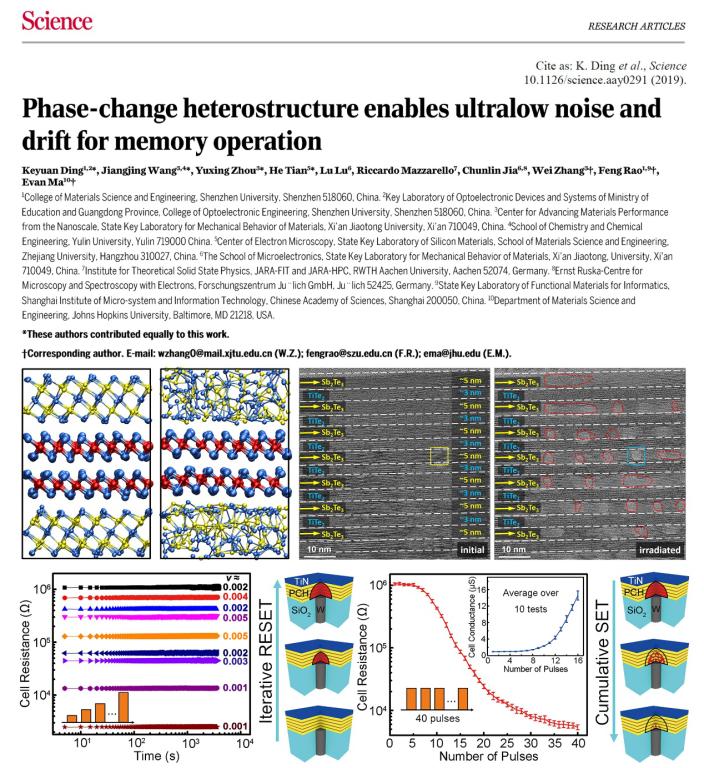Paper accepted by Science: Phase-change heterostructure enables ultralow noise and drift for memory operation
The rapid development of artificial intelligence (AI), big data analytics and supercomputing demands a fundamental change in the current computing systems based on von Neumann architecture, which is characterized by physically separated processing and storage units. Their inter-communication across bandwidth-limited and energy-inefficient interconnects constitutes a bottleneck for data shuffling, leading to a 40 % power waste. Chalcogenide phase-change materials (PCMs) based random-access memory (PCRAM), available as storage-class memory (SCM) in the memory market, can mitigate to some extent the performance mismatch between dynamic random access memory (DRAM) and flash-memory based solid-state drive (SSD). But to fundamentally break the aforementioned bottleneck, non-von Neumann computing architecture that unifies computing with storage in memory cells, such as neuro-inspired computing, needs to be pursued. PCRAM are a promising route for the implementation of this new form of computing, however, current PCRAM products for binary data storage suffer from strong intra- and inter-cell variability due to the spontaneous structural relaxation of amorphous PCMs and the randomness associated with the crystallization kinetics.
To respond to this critical challenge, an international team from Xi’an Jiaotong University (China), Shenzhen University (China), Zhejiang University (China), Yulin University (China), Chinese Academy of Sciences—Shanghai Institute of Micro-system and Information Technology (China), RWTH Aachen University (Germany), Research Center Jülich (Germany) and Johns Hopkins University (USA) has developed a new design of the programming layer, replacing the original GeSbTe alloy by a phase-change heterostructure (PCH) consisting of alternately stacked phase-change and confinement nanolayers, which suppressed the glass relaxation and structural variability for memory operations with ultralow noise and drift. In particular, the PCH based PCRAM devices enabled well-controlled iterative RESET (amorphization with varied volume) and cumulative SET (stepwise crystallization) that served as the corner stone for implementations of in-memory computing, deep neural networks and spiking neural networks. The PCH approach is amenable to industrial production, because the multilayer deposition does not much increase the fabrication cost or demand complex procedure, making it easy to be incorporated into state-of-the-art device setups for high-performance neuromorphic chips.
This work has been published as a research article entitled “Phase-change heterostructure enables ultralow noise and drift for memory operation” by Science on Aug 22, 2019, DOI: 10.1126/science.aay0291. The author team includes Dr. Keyuan Ding, Dr. Jiangjing Wang, Mr. Yuxing Zhou, Prof. He Tian, Dr. Lu Lu, Prof. Chunlin Jia, Prof. Riccardo Mazzarello, Prof. Wei Zhang, Prof. Feng Rao and Prof. Evan Ma. The author team can be reached at wzhang0@mail.xjtu.edu.cn, fengrao@szu.edu.cn, ema@jhu.edu.
The article can be accessed via:https://science.sciencemag.org/content/early/2019/08/21/science.aay0291


